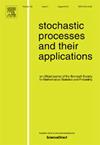通过种群动态的连续图动力学:适定性、对偶性和均衡性
IF 1.2
2区 数学
Q3 STATISTICS & PROBABILITY
引用次数: 0
摘要
本文介绍了图素,一个用于构造和分析描述大型动态图演化的随机过程的新框架。与非常适合研究静态密集图并与可交换随机图的Aldous-Hoover表示密切相关的图素不同,图素允许对动态密集图的完整时空演化进行建模,超出了图素理论中使用的可交换性和子图频率。grapheme被定义为三元组的等价类,由波兰空间、该空间上的对称{0,1}值连接函数(表示连接顶点的边)和采样概率度量组成。我们专注于嵌入在超尺度空间中的字素,其中超尺度编码图形进化的谱系,从而与群体遗传学建立直接联系。字形框架强调嵌入,特别是在波兰的空间中,并使用了更强的等效概念(同态和等距),而不是Aldous-Hoover表示下的互换性。我们构建了作为有限图进化极限的字素值马尔可夫过程,其驱动规则类似于群体遗传学中的Fleming-Viot、Dawson-Watanabe和McKean-Vlasov过程。我们建立了这些石墨烯动力学的特征是适定的鞅问题,导致具有Feller性质的强马尔可夫过程和连续路径(即扩散)。我们进一步利用聚结过程推导了对偶关系,并确定了动态字素的平衡,表明这些与群体遗传学中产生的经典分布有关,因此可能是非平凡的。我们的方法扩展和修改了以前在图形动力学方面的工作(Athreya等人,2021),提供了一个更通用的框架,其中包括图形历史的自然表示。这允许通过鞅问题对动力学进行严格的处理,并产生非平凡平衡的特征。本文章由计算机程序翻译,如有差异,请以英文原文为准。
Continuum graph dynamics via population dynamics: Well-posedness, duality and equilibria
This paper introduces graphemes, a novel framework for constructing and analysing stochastic processes that describe the evolution of large dynamic graphs. Unlike graphons, which are well-suited for studying static dense graphs and which are closely related to the Aldous–Hoover representation of exchangeable random graphs, graphemes allow for a modelling of the full space–time evolution of dynamic dense graphs, beyond the exchangeability and the subgraph frequencies used in graphon theory. A grapheme is defined as an equivalence class of triples, consisting of a Polish space, a symmetric -valued connection function on that space (representing edges connecting vertices), and a sampling probability measure.
We focus on graphemes embedded in ultrametric spaces, where the ultrametric encodes the genealogy of the graph evolution, thereby drawing a direct connection to population genetics. The grapheme framework emphasises the embedding, in particular, in Polish spaces, and uses stronger notions of equivalence (homeomorphism and isometry) than the exchangeability underlying the Aldous–Hoover representation. We construct grapheme-valued Markov processes that arise as limits of finite graph evolutions, driven by rules analogous to the Fleming–Viot, Dawson–Watanabe and McKean–Vlasov processes from population genetics. We establish that these grapheme dynamics are characterised by well-posed martingale problems, leading to strong Markov processes with the Feller property and continuous paths (i.e., diffusions). We further derive duality relations by using coalescent processes, and identify the equilibria of dynamic graphemes, showing that these are linked to classical distributions arising in population genetics and can therefore be non-trivial.
Our approach extends and modifies previous work on graphon dynamics (Athreya et al., 2021), by providing a more general framework that includes a natural representation of the history of the graph. This allows for a rigorous treatment of the dynamics via martingale problems, and yields a characterisation of non-trivial equilibria.
求助全文
通过发布文献求助,成功后即可免费获取论文全文。
去求助
来源期刊

Stochastic Processes and their Applications
数学-统计学与概率论
CiteScore
2.90
自引率
7.10%
发文量
180
审稿时长
23.6 weeks
期刊介绍:
Stochastic Processes and their Applications publishes papers on the theory and applications of stochastic processes. It is concerned with concepts and techniques, and is oriented towards a broad spectrum of mathematical, scientific and engineering interests.
Characterization, structural properties, inference and control of stochastic processes are covered. The journal is exacting and scholarly in its standards. Every effort is made to promote innovation, vitality, and communication between disciplines. All papers are refereed.
 求助内容:
求助内容: 应助结果提醒方式:
应助结果提醒方式:


